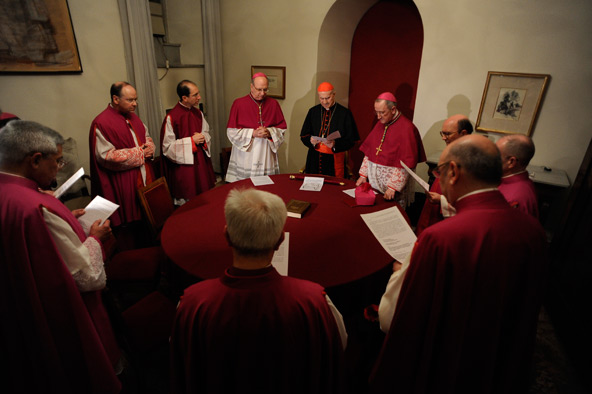
VATICAN CITY (CNS) — Cardinal-electors are caught in a Catch-22. They are eager to give the world a new pope; however, they need time to pick the right leader, said South Africa’s cardinal.
“There might be a need for a long delay” as the cardinals try to gauge how much they do or don’t know enough about each other, Cardinal Wilfrid Napier told Catholic News Service March 1, the first day of the “sede vacante.”
No church leader wants to be away from his diocese for too long, he said, and no one wants to miss Easter, March 31.
“Yet no cardinal, on the other hand, wants this process to be fouled up by ill-considered actions” and haste, he said.
Because there will be no mourning period, which usually lasts at least 10 days after the death of a pope, he said there may be many cardinals here in Rome who are thinking “‘If we’re all here, why should we delay it?'”
“There’s a whole church out there that needs to get an answer, and I’d say sooner rather than later, but they want the right answer,” he said.
The quandary is: “Are we going to get the right person if we hurry things up? Will we get a better person if we slow things” down, he asked.
One part of the process begins March 4 with the general congregations, daily meetings in which the cardinals prepare for a conclave, discuss the needs of the church and handle more serious church business that must be attended to between popes. Cardinals over 80 may participate in these meetings, but they are not required to. The general congregations end when the cardinal-electors enter into conclave.
Cardinals will use informal meetings and the general congregations to get to know each other. But a key part of the general meetings will be to exchange views and reports about the various situations of the church in different parts of the world, he said.
That way, when they go into the conclave, the cardinals will “have a better idea of the kind of pope we’re going to need — some of the issues the pope will have to deal with,” he said, and the one elected pope “will already be quite aware of some of the profound needs” that require attention, he said.
While in 2005 the Easter celebrations, funeral Mass and general congregations led by the then-dean of the College of Cardinals, Cardinal Joseph Ratzinger, gave the German cardinal a platform to show his skills as a speaker, pastor and listener, Cardinal Napier said the congregations will also give lesser-ranked cardinals a chance to shine.
“I believe that during (the general) congregations we will probably have contributions from some outstanding characters that will really get us thinking ‘This is a possible person’ and perhaps narrowing down the possibilities” to probabilities, he said.
He said, “I feel with this conclave coming up, I’ve had far more exposure to the other cardinals than before the first conclave” he participated in, in 2005.
Appointed to the College of Cardinals in 2001, Cardinal Napier said that during his first four years as cardinal, he hardly ever got to know the other members.
That changed in large part thanks to Pope Benedict, he said.
“When there was a consistory, invariably he’d call the cardinals to a meeting a day before,” which gave them an added chance to get together.
“That doesn’t mean I still don’t have to look up on Google” to see who is who and match a face to a name, he added, laughing.
But the cardinal won’t put all his trust in the powers of the Internet, he said; “We’ll have to put a lot of faith in the presence and activity of the Holy Spirit” in helping them make decisions.
Cardinal Napier, who was ordained a Franciscan priest in 1970, said the 2013 conclave will be a bit harder because “there’s a wider field of choices.”
This time around there are “younger cardinals who, I believe, have real qualities of leadership,” said the 71-year-old Archbishop of Durban, who turns 72 March 8.
He said age is going to be a big factor, with the ideal candidate being between 60 and 65 years old.
Not only is the mental and physical stamina of a younger man needed, “I don’t think we can have another short pontificate.”
That’s because time will be needed for a new pope to build on the important foundations left behind by Blessed John Paul II and retired Pope Benedict XVI and build “momentum that grows in sync with the needs and demands that are becoming more evident,” he said.
Like Blessed John Paul, it will be important the new pope travel the world, visiting the Catholic faithful, he said. A papal visit makes the Catholic Church “a living reality” for people and revitalizes and reaffirms their faith, which is especially crucial for the new evangelization, he said.
The new pope also will have to build on the retired pope’s legacy of putting Christ at the center of one’s life and seeing faith as an active, living experience of God, he said.
Cardinal Napier recalled that, during his last meeting with the cardinals Feb. 28, Pope Benedict told them they have to be “an orchestra” that works together harmoniously despite their differences.
No matter what, the new pope “cannot do it alone,” the cardinal said. He “is going to have to make sure he gets like-minded leadership together with him in the Vatican to be able to move the process forward.”
— By Carol Glatz Catholic News Service





